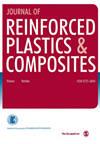Preparation of highly biodegradable and electron beam crosslinkable linear low-density polyethylene - based biocomposites with unique mechanical performance
IF 2.2
3区 材料科学
Q3 MATERIALS SCIENCE, COMPOSITES
引用次数: 0
Abstract
Preparation of high starch containing LLDPE (linear low-density polyethylene)/starch composite with a considerable degree of mechanical properties has always been a challenge for a long time. These challenges are low thermal stability of starch, difficulties in processability of high starch containing LLDPE, inability of polymers to contain large quantities of starch and compromised mechanical properties of prepared composites. To overcome these difficulties, 20 wt% ENGAGE (ethylene-octene copolymer), a polyolefin elastomer, was blended with 80 wt% LLDPE followed by composites preparation with modified starch-pistachio shell powder (SPSP). ENGAGE, due to its unique processability, improved the processability of high SPSP-containing LLDPE composite. And due to the generation of extra space by amorphous ENGAGE, the LLDPE/ENGAGE blends could accommodate up to 70 wt% SPSP without any degradation during high-temperature processing. Mechanical properties were also considerably enhanced due to the reinforcement of the polymer matrix by pistachio shell powder (PSP). SEM and dynamic mechanical analysis (DMA) confirmed the structural integrity of processed composites and uniform dispersion of SPSP into LLDPE/ENGAGE blends. The obtained LLDPE-based composites with 70% biodegradability and around 240% elongation are unique and useful. It is also revealed that the presence of 20 wt% PSP inhibits electron beam-initiated degradation of starch instead leading to crosslinked network in composites, thus further enhancing properties.制备具有独特机械性能的高生物降解性和电子束交联线性低密度聚乙烯基生物复合材料
长期以来,制备具有相当高机械性能的高淀粉含量 LLDPE(线性低密度聚乙烯)/淀粉复合材料一直是一项挑战。这些挑战包括:淀粉的热稳定性低、高淀粉含量 LLDPE 的加工困难、聚合物无法含有大量淀粉以及所制备复合材料的机械性能受到影响。为了克服这些困难,我们将 20 wt% 的 ENGAGE(乙烯-辛烯共聚物)(一种聚烯烃弹性体)与 80 wt% 的 LLDPE 混合,然后用改性淀粉-开心果壳粉末 (SPSP) 制备复合材料。ENGAGE 凭借其独特的加工性能,改善了高 SPSP 含量 LLDPE 复合材料的加工性能。由于无定形 ENGAGE 产生了额外的空间,LLDPE/ENGAGE 混合物可以容纳高达 70 wt% 的 SPSP,而不会在高温加工过程中发生任何降解。由于开心果外壳粉末(PSP)对聚合物基体进行了增强,其机械性能也得到了显著提高。扫描电镜和动态机械分析(DMA)证实了加工复合材料的结构完整性以及 SPSP 在 LLDPE/ENGAGE 混合物中的均匀分散。所获得的基于 LLDPE 的复合材料具有 70% 的生物可降解性和约 240% 的伸长率,是一种独特而有用的材料。研究还发现,20 wt% PSP 的存在可抑制电子束引发的淀粉降解,从而在复合材料中形成交联网络,从而进一步提高性能。
本文章由计算机程序翻译,如有差异,请以英文原文为准。
求助全文
约1分钟内获得全文
求助全文
来源期刊

Journal of Reinforced Plastics and Composites
工程技术-材料科学:复合
CiteScore
5.40
自引率
6.50%
发文量
82
审稿时长
1.3 months
期刊介绍:
The Journal of Reinforced Plastics and Composites is a fully peer-reviewed international journal that publishes original research and review articles on a broad range of today''s reinforced plastics and composites including areas in:
Constituent materials: matrix materials, reinforcements and coatings.
Properties and performance: The results of testing, predictive models, and in-service evaluation of a wide range of materials are published, providing the reader with extensive properties data for reference.
Analysis and design: Frequency reports on these subjects inform the reader of analytical techniques, design processes and the many design options available in materials composition.
Processing and fabrication: There is increased interest among materials engineers in cost-effective processing.
Applications: Reports on new materials R&D are often related to the service requirements of specific application areas, such as automotive, marine, construction and aviation.
Reports on special topics are regularly included such as recycling, environmental effects, novel materials, computer-aided design, predictive modelling, and "smart" composite materials.
"The articles in the Journal of Reinforced Plastics and Products are must reading for engineers in industry and for researchers working on leading edge problems" Professor Emeritus Stephen W Tsai National Sun Yat-sen University, Taiwan
This journal is a member of the Committee on Publication Ethics (COPE).
 求助内容:
求助内容: 应助结果提醒方式:
应助结果提醒方式:


